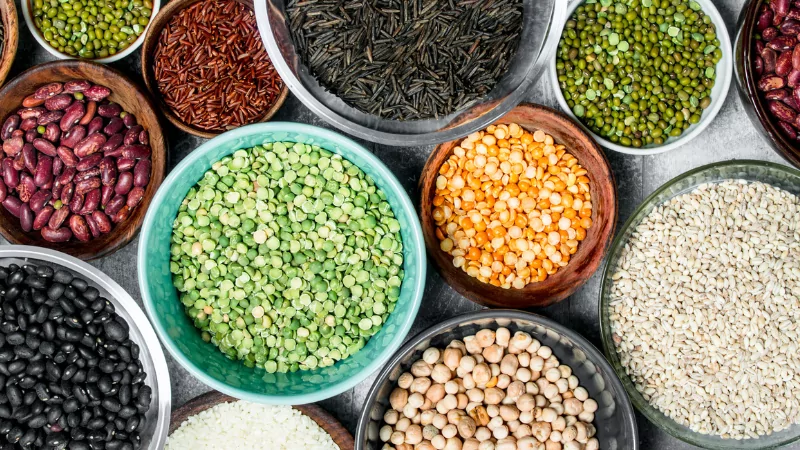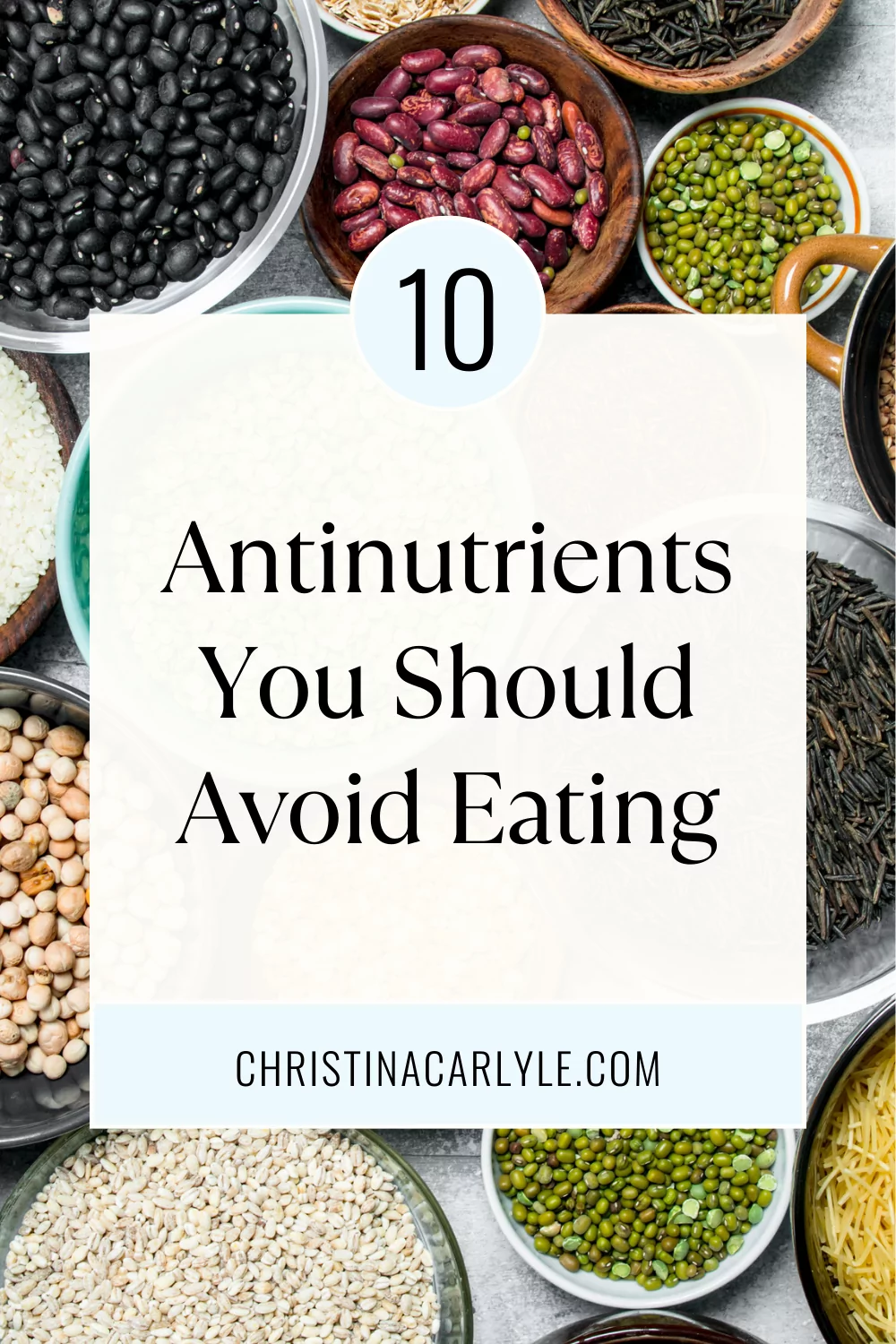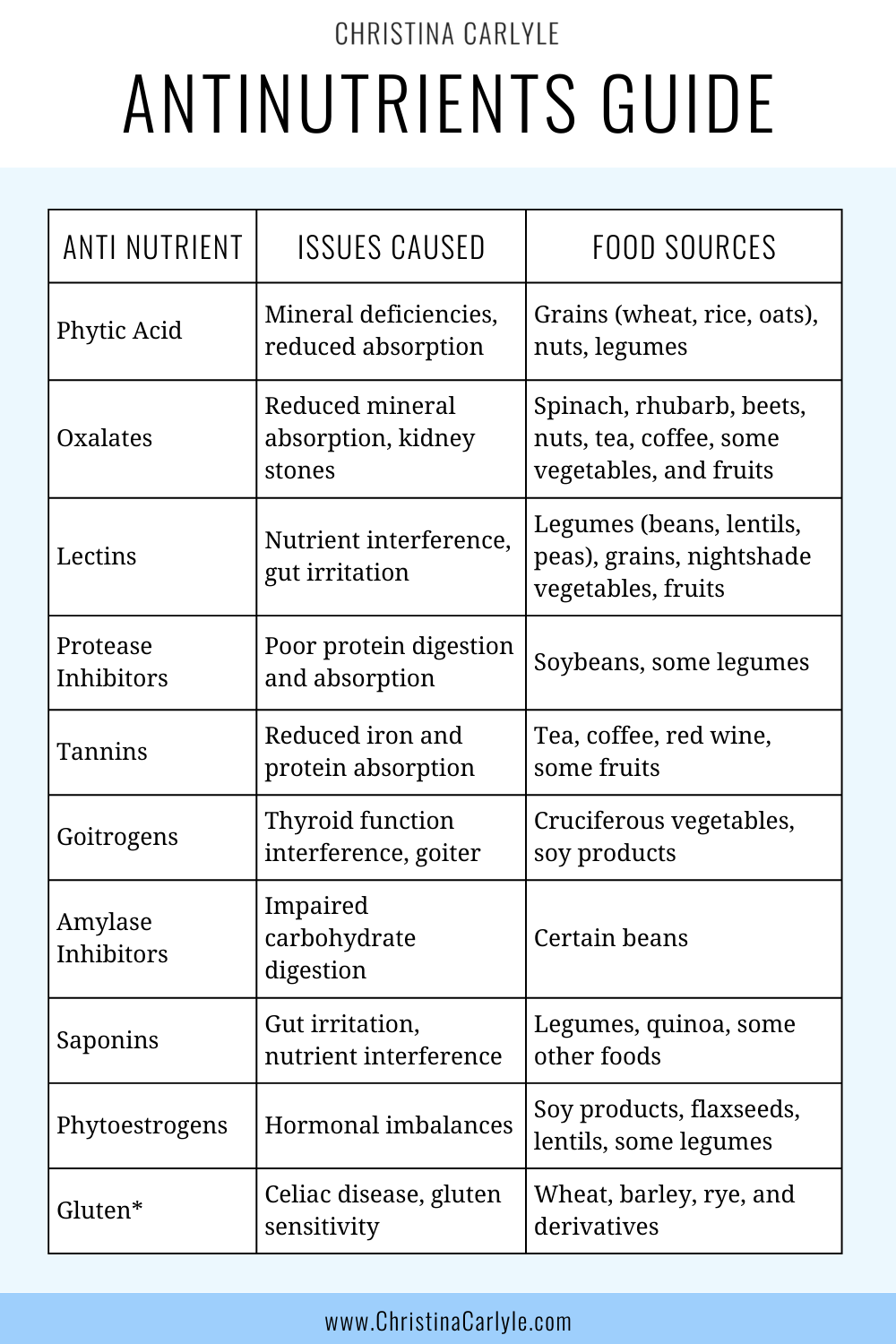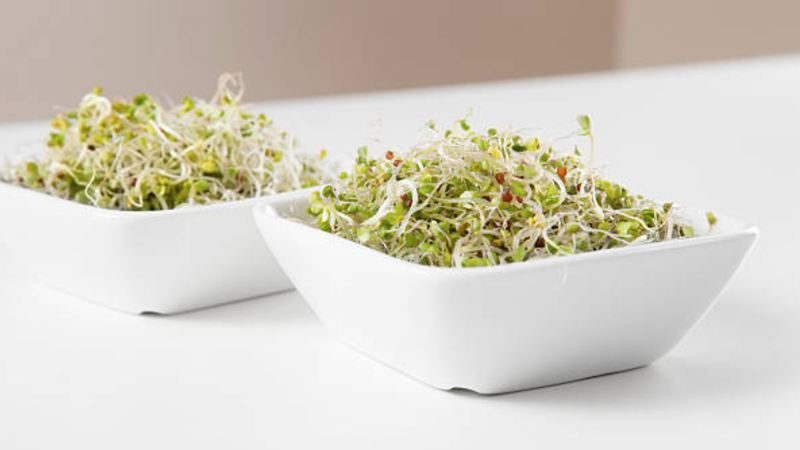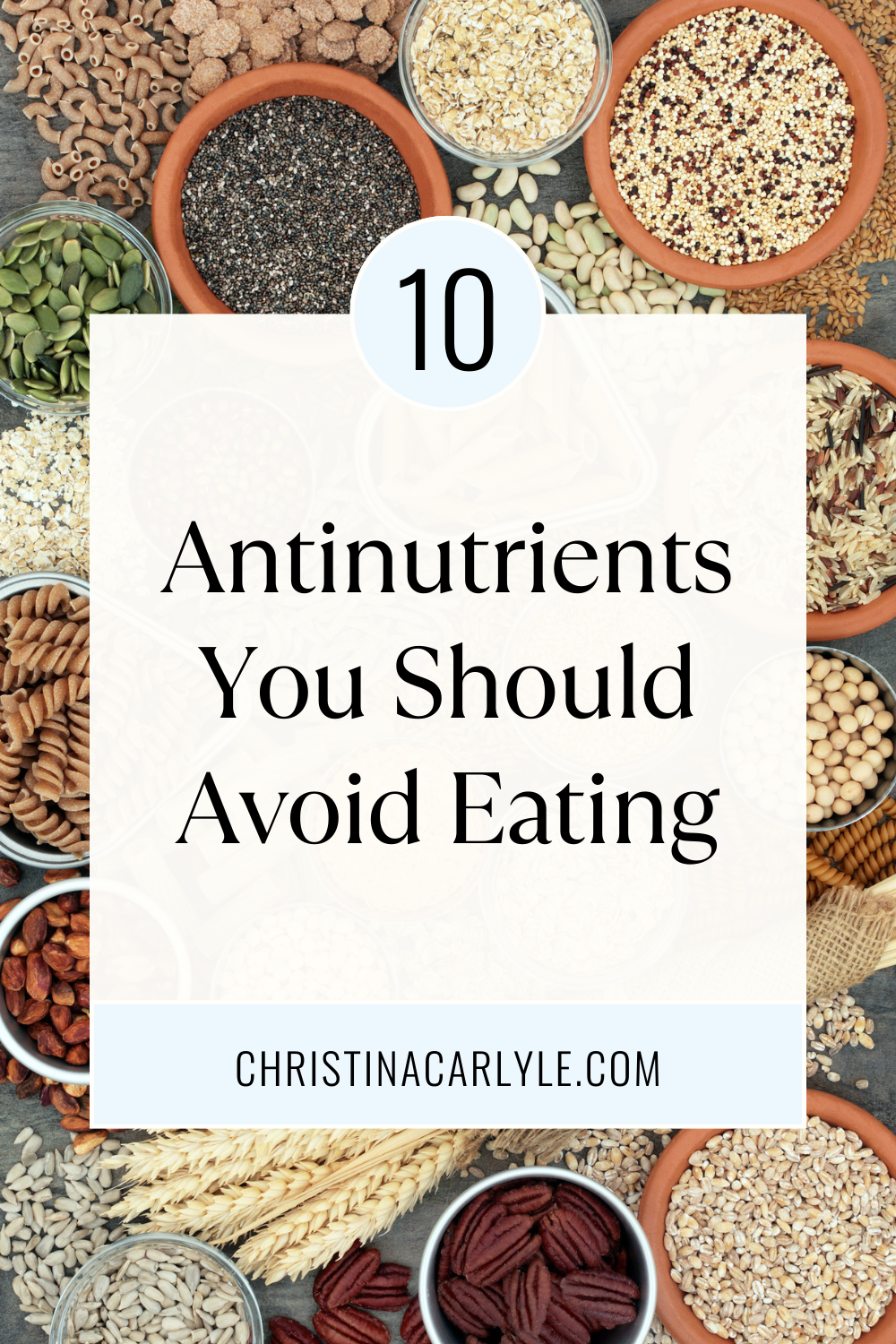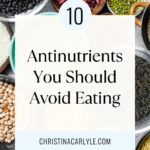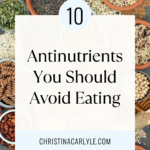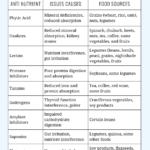Last Updated on August 14, 2023
Antinutrients are an important subset of food that can affect your fitness and wellness goals… but I find that most people don’t know what they are. In fact, most antinutrients are found in healthy foods. But all foods have a front and a back. Meaning they can have benefits and consequences. Antinutrients can have some pretty serious consequences…
I have SO MANY clients that come to me struggling with weight and health issues. Then they ‘eat healthy’ but don’t get the results they expected. In a lot of cases, it’s because the ‘healthy’ foods had unhealthy consequences. And antinutrients are a prime example of this.
Antinutrients should be avoided if you have GI issues (gas, bloating, irregularity, etc.), hormone issues, nutrient absorption issues, or an autoimmune condition… or metabolic dysfunction present. If metabolic dysfunction is present, I recommend avoiding antinutrients altogether.
That’s why I’m doing a deep dive all about anti-nutrients.
You’ll learn:
- What antinutrients are
- The 10 main types of antinutrients to be aware of (including what foods have them and the issues they can cause/make worse)
- Who should avoid antinutrients
- How to reduce antinutrients in food
Sound good? Let’s dig in!
First things first…
What are Antinutrients?
Antinutrients are naturally occurring compounds found in certain foods that can interfere with the absorption and utilization of nutrients in the body. While some antinutrients may offer health benefits in moderation, excessive consumption can have negative effects on health and weight.
Antinutrients include compounds like phytic acid, oxalates, lectins, protease inhibitors, tannins, goitrogens, amylase inhibitors, saponins, and phytoestrogens, as well as gluten for individuals with celiac disease or gluten sensitivity. Each of these antinutrients may have different effects on nutrient absorption and utilization.
HINT: It’s estimated that 89% of the population has mineral deficiencies… so eating antinutrients can exacerbate nutrient deficiencies and absorption issues, leading to metabolic dysfunction.
Antinutrients can have both direct and indirect effects on weight and overall health. Directly, antinutrients can hinder the absorption of essential minerals and nutrients, leading to deficiencies and imbalances in the body.
For instance, phytic acid in grains, nuts, and legumes can bind to minerals like calcium, iron, zinc, and magnesium, reducing their absorption. This can result in weakened bones, anemia, and impaired immune function, potentially affecting energy levels and physical activity, which may contribute to weight-related issues.
Indirectly, antinutrients can cause gut irritation, inflammation, and compromise the integrity of the gastrointestinal lining, affecting nutrient absorption and digestion. This can cause gut health issues leading to gastrointestinal discomfort, reduced appetite, and altered metabolism, influencing weight management.
Some antinutrients, like lectins, can promote leptin resistance, impacting appetite regulation and body weight control. While antinutrients are present in many foods, they are not inherently harmful and can be managed through a varied and balanced diet, diverse food preparation methods, and individual awareness of sensitivities or health conditions. These are just a few examples of how antinutrients can affect health and weight…
It’s essential to remember that not all antinutrients are inherently harmful, and some may even have health benefits in moderate amounts.
Think of a food – any food – like puzzle made up of different pieces – fiber, nutrients, enzymes, etc. An antinutrient can be ‘one piece’ of a food’s ‘puzzle.’ Meaning a majority of the food could be ‘good’ or ‘healthy’ but an individual’s unique metabolic needs, sensitivities, or issues with organ/cell/bodily function may make them susceptible to harm/damage of the ‘bad’ antinutrient. In some cases, the harmful effects of the ‘bad’ antinutrients outweigh the benefits of the nutrients.
A balanced and varied diet, along with appropriate food preparation methods, can help manage the potential negative effects of antinutrients while allowing individuals to benefit from the many nutrients and health-promoting compounds found in a wide range of foods… and I’ll share those methods in a bit.
Until then, there are antinutrients that should be avoided altogether… Especially if you have a preexisting sensitivity or condition that would be made worse by antinutrient compounds.
So let’s go over what the different antinutrients are, then who should avoid them like the plague, and easy methods to reverse antinutrient content so you can avoid issues.
10 Antinutrients to Watch Out for
Let’s dig into each antinutrient, the most common food sources that contain them, the potential issues they can cause, and who should avoid consuming them.
Phytic Acid (Phytates)
- What it is: Phytic acid is a compound found in the seeds, grains, nuts, and legumes of many plants. It acts as a storage form of phosphorus in plants.
- Foods: Whole grains (wheat, rice, oats), nuts, seeds, legumes (beans, lentils, chickpeas).
- Potential Issues: Phytic acid binds to minerals like calcium, iron, zinc, and magnesium, inhibiting their absorption in the digestive tract. This can lead to mineral deficiencies, particularly in populations with diets heavily reliant on these foods.
- Who should avoid them: While phytic acid is present in many foods, individuals with mineral deficiencies or those with diets predominantly based on phytic acid-rich foods may consider diversifying their diet or using preparation methods like soaking, fermenting, or sprouting to reduce phytic acid content.
Oxalates
- What they are: Oxalates are natural compounds found in many plant foods. They are involved in the plant’s defense mechanism against herbivores.
- Food Sources: Spinach, rhubarb, beets, Swiss chard, nuts, soy products, tea, coffee, and some other vegetables and fruits.
- Potential Issues: Oxalates can bind with minerals, especially calcium, to form insoluble crystals. This can reduce calcium absorption and, in high amounts, contribute to the development of kidney stones in susceptible individuals.
- Who should avoid them: People prone to kidney stones or with calcium oxalate-related conditions may need to limit their consumption of high-oxalate foods.
Lectins
- What they are: Lectins are proteins found in various plant foods, acting as a defense mechanism against pests.
- Food Sources: Legumes (beans, lentils, peas), grains (wheat, barley, rice), nightshade vegetables (tomatoes, eggplants, peppers), and some fruits.
- Potential Issues: Lectins can interfere with nutrient absorption in the gut and may lead to gut irritation and inflammation. Some studies suggest they might also contribute to leptin resistance, potentially affecting appetite regulation and metabolism.
- Who should avoid them: People with digestive issues or autoimmune conditions may consider reducing lectin-rich foods or using methods like soaking, fermenting, or pressure cooking to reduce lectin levels.
Protease Inhibitors:
- What they are: Protease inhibitors are proteins that hinder the activity of digestive enzymes called proteases.
- Food Sources: Soybeans and other legumes, to a lesser extent.
- Potential Issues: Protease inhibitors can reduce protein digestion and absorption, which may lead to poor protein utilization.
- Who should avoid them: Individuals who consume large amounts of raw soy products should be cautious. Cooking can help reduce protease inhibitor levels.
Tannins:
- What they are: Tannins are polyphenolic compounds that give certain foods a bitter or astringent taste.
- Foods: Tea, coffee, red wine, certain fruits (grapes, pomegranates).
- Potential Issues: Tannins can inhibit the absorption of iron and protein, potentially leading to iron deficiency and reduced protein utilization.
- Who should avoid them: People with iron deficiency anemia may need to moderate their intake of tannin-rich foods and beverages.
Goitrogens:
- What they are: Goitrogens are compounds that can interfere with thyroid function by inhibiting iodine uptake.
- Food Sources: Cruciferous vegetables (broccoli, cauliflower, cabbage, kale), soy products.
- Potential Issues: High goitrogen intake may contribute to goiter or negatively affect thyroid function, particularly in individuals with iodine deficiency or those susceptible to thyroid disorders.
- Who should avoid them: People with thyroid conditions or iodine deficiency should be mindful of their goitrogen intake. Cooking or fermenting cruciferous vegetables can reduce goitrogen levels.
Amylase Inhibitors:
- What they are: Amylase inhibitors are compounds that hinder the activity of the enzyme amylase, responsible for carbohydrate digestion.
- Food Sources: Some beans, particularly kidney beans.
- Potential Issues: Amylase inhibitors can slow down carbohydrate digestion, potentially leading to flatulence and gastrointestinal discomfort.
- Who should avoid them: Individuals sensitive to the specific type of amylase inhibitors found in certain beans may consider alternative sources of carbohydrates.
Saponins:
- What they are: Saponins are chemical compounds found in various plant foods, known for their soap-like properties.
- Food Sources: Legumes (beans, chickpeas, lentils), quinoa, and certain other foods.
- Issues: Saponins can affect the permeability of the gut lining and may interfere with nutrient absorption. In high amounts, they could cause gut irritation.
- Who should avoid them: People with sensitive digestive systems may consider reducing their intake of saponin-rich foods. Cooking or rinsing legumes and quinoa can help reduce saponin levels.
Phytoestrogens:
- What they are: Phytoestrogens are naturally occurring compounds found in certain plant foods that have a chemical structure similar to estrogen, a hormone in the human body.
- Food Sources: Soybeans and soy products (tofu, tempeh, soy milk), flaxseeds, sesame seeds, lentils, chickpeas, and some other legumes.
- Potential Issues: Phytoestrogens can bind to estrogen receptors in the body and mimic the hormone’s effects to some extent. While this can have potential health benefits, excessive consumption of phytoestrogens may lead to hormonal imbalances, especially in sensitive individuals or those with preexisting hormone-related conditions.
- Who should avoid them: Individuals with certain hormone-related conditions, such as estrogen-sensitive breast cancers or thyroid disorders, may need to moderate their intake of phytoestrogen-rich foods. Pregnant or breastfeeding women should also be cautious about excessive consumption, as it might affect hormonal balance.
Gluten:
- What it is: Gluten is a group of proteins found in wheat, barley, rye, and their derivatives. It is responsible for the elastic texture of dough and is widely used in the food industry.
- Food Sources: Wheat-based products like bread, pasta, cereals, and baked goods; barley-based products, such as beer; and rye-based foods.
- Potential Issues: Gluten can be problematic for individuals with celiac disease, a severe autoimmune disorder triggered by the ingestion of gluten. In celiac disease, the immune system mistakenly attacks the lining of the small intestine when gluten is consumed, leading to inflammation and damage. This impairs nutrient absorption and can cause various symptoms, including digestive issues, weight loss, and nutritional deficiencies.
- Who should avoid them: People with celiac disease must strictly avoid gluten-containing foods to manage their condition effectively. Additionally, some individuals may have non-celiac gluten sensitivity, experiencing similar symptoms to celiac disease without the autoimmune response. They may also benefit from reducing or eliminating gluten from their diets.
It’s crucial to distinguish between gluten sensitivity and celiac disease as both have their own diagnostic tests but regardless if the reaction is a mild sensitivity or a more severe immune reaction – gluten should be avoided.
With other antinutrients, it can be a little tricky because antinutrients are found in a lot of healthy foods. In most cases, the benefits of the healthy nutrients outweigh the damage done by the antinutrients.
But there are some people that I would recommend avoiding antinutrients altogether if they have specific health issues.
Who should not eat antinutrients?
People with certain health conditions or sensitivities may benefit from reducing or avoiding antinutrients in their diets. I find the following individuals should be cautious and avoid eating antinutrients:
- Individuals with mineral deficiencies: Those who have a history of mineral deficiencies or are at risk of developing them may consider reducing antinutrients like phytic acid, which can hinder mineral absorption. Adequate mineral intake is crucial for maintaining overall health. Again, it’s estimated that approximately 89% of the population is mineral deficient, so monitor your antinutrient intake closely.
- Individuals with kidney stones or kidney issues: People prone to kidney stones or with calcium oxalate-related conditions should limit their consumption of high-oxalate foods to minimize the risk of stone formation. Oxalates can bind to minerals like calcium and form insoluble crystals, contributing to kidney stones. If you have any liver or gallbladder issues avoid antinutrients as they put a heavier strain on kidney function.
- People with digestive issues or autoimmune conditions: Individuals with digestive issues or autoimmune disorders may experience gut irritation and inflammation due to antinutrients like lectins. Reducing lectin-rich foods or using preparation methods like soaking, fermenting, or pressure cooking may be beneficial.
- Those with thyroid conditions or iodine deficiency: Individuals with thyroid disorders or iodine deficiency should be mindful of their goitrogen intake. Goitrogens can interfere with thyroid function and may contribute to goiter in susceptible individuals.
- Individuals with iron deficiency anemia: People with iron deficiency anemia should moderate their intake of tannin-rich foods and beverages, as tannins can inhibit iron absorption and exacerbate the condition.
- Individuals with hormone-related conditions: People with hormone-related conditions, such as estrogen dominance, estrogen-sensitive breast cancers, or thyroid disorders, low progesterone, or adrenal issues should moderate their intake of phytoestrogen-rich foods. Pregnant or breastfeeding women should also be cautious about excessive consumption of phytoestrogens.
- Individuals with celiac disease or gluten sensitivity: Those diagnosed with celiac disease must strictly avoid gluten-containing foods, as gluten can trigger severe autoimmune responses in these individuals. Some people may also have non-celiac gluten sensitivity and may benefit from reducing or eliminating gluten from their diets.
How to Reduce Anti-Nutrients in Food
Reducing antinutrients in food can be achieved through various preparation and processing methods. These methods can help improve nutrient bioavailability and reduce the potential negative effects of antinutrients. Here are some effective ways to reduce antinutrients in food:
- Soaking: Soaking certain foods in water can help leach out antinutrients. For example, soaking grains, legumes, nuts, and seeds in water for several hours or overnight can reduce phytic acid levels.
- Sprouting: Sprouting involves germinating seeds, legumes, or grains by soaking them in water until they sprout. Sprouting reduces antinutrient content and increases the availability of nutrients. It is particularly effective in reducing phytic acid levels. Here’s a tutorial on how to sprout broccoli seeds. You can sprout any seed using this method.
- Fermentation: Fermenting foods using beneficial microorganisms can break down antinutrients and enhance nutrient absorption. Fermented foods like yogurt, kefir, miso, and tempeh have reduced levels of antinutrients compared to their unfermented counterparts. Fermented foods also have beneficial probiotics and I recommend eating high probiotic foods daily.
- Cooking: Cooking is a common method to reduce antinutrient levels. Heat can inactivate or break down some antinutrients, making the nutrients more bioavailable. Boiling, steaming, and roasting are effective cooking techniques.
- Blanching: Blanching involves briefly immersing vegetables in boiling water and then rapidly cooling them. This method can help reduce the levels of certain antinutrients in vegetables.
- Grinding or Milling: Processing grains and legumes by grinding or milling can help reduce antinutrient levels. Traditional methods like stone grinding and milling also have a positive effect on nutrient availability.
- Using Food Combinations: Pairing foods rich in antinutrients with those that contain substances that counteract their effects can improve nutrient absorption. For example, vitamin C from fruits and vegetables can enhance non-heme iron absorption from plant-based sources. FYI My meal plans have the best nutrient combinations for health and fitness. That’s how I get people rapid results.
- Discarding Soaking Water: When soaking foods to reduce antinutrients, it is essential to discard the soaking water. This water contains leached-out antinutrients, so using fresh water for cooking or consumption is necessary.
- Selecting Appropriate Varieties: Some plant varieties have naturally lower levels of anti-nutrients. Choosing these varieties can be beneficial, especially for individuals sensitive to certain antinutrients.
It’s important to note that while these methods can help reduce antinutrient levels, they may not completely eliminate them. However, a balanced diet that includes a variety of foods and preparation methods can ensure adequate nutrient intake while minimizing the potential negative effects of antinutrients.
It’s also important to note that consuming antinutrients can cause nutrient deficiencies and imbalances that cause metabolic dysfunction and make it worse.
I recommend this free training to see if you have any symptoms of metabolic dysfunction.
After your metabolic analysis, I’ll explain your results and recommend a plan that’ll get you healthy and fit ASAP.
I hope this deep dive into antinutrients helped you.
Your Coach and Biggest Cheerleader,
![]()
PS. Save this post to Pinterest so you’ll have it forever.
If you liked this post you’ll also like:
- How to Stop a Sugar Craving in Seconds
- Health Cooking Oil Guide
- Best Foods for Gut Health and Weight Weight Loss
- Hormones and Weight Gain

